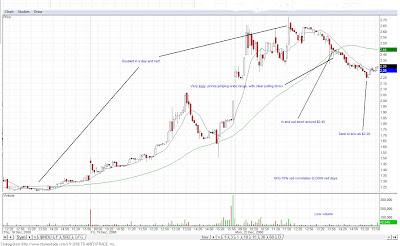I was busy all morning, and finally did some PM paper trading into the market’s close. Man, there are often big swings at the end of the day. Today I was going solo and not taking advantage of the Investors Live chatroom. I am getting more adept at looking at a chart and spotting set-ups, reading the direction the stock is heading, etc. For example, I saw SFI breaking down after lunch but I couldn’t get shares to borrow. I also spotted EPIX on TD Ameritrade’s Motion Detector and was loaded up to buy at .58 on FDA news, but got spooked out. Closed at $1.10 today. So the execution of this analysis is what is lagging. Today, I made only made one paper trade. But I left lots of money on the table. I manually lifted my stop order to exit as I thought the stock was moving against me, so it turned into a -$10 loss, instead of a couple hundred profit if I had just been patient.
This isn’t the first time this has happened, where I panicked and didn’t let a trade breath. I looked back at all posts over the last two months and saw a big pattern – many of my losing trades were a result of exiting way too soon, either by over-riding a stop order or having too tight of a stop order. So I decided I need to formalize my trading “policies” to help in my implementation of the intraday momentum strategy I’m following and outlined in this post:
1) Position sizes of no more than $2,500. For cheap stocks, I don’t want a position size with a sway of more than $2o a penny – so a limit of 2,000 shares.
2) Stop orders will be set at $150 for now to let trades breath (currently I’ve been using $100 – this will be re-evaluated as this may not be good risk management).
3) Rarely over-ride stop orders, rather using trailing stops. One exception is when bids/asks get jiggy and its obvious that its going to pop or drop based on Level II, but this has to be a technical turn around and not emotional based on fear and panic.
4) Wait 1o minutes after open to enter positions, may exit stock to take profits or minimize loss on overnight bad news during first 1o minutes.
5) Once I make a decision on a trade, stay focused and enter quickly.
6) Double check my order details to ensure accuracy (e.g. don’t long when you want to short, don’t put a limit order in when you want a stop order, right price, etc.).
7) Don’t chase; wait for a pull back and consider entering then.
8) Don’t long / short at well-developed resistance / support levels unless it’s a clear breakout.
9) Go long early with penny stocks on positive drug news (don’t chase still) and look to flip later after they hyper-inflate (this seems to be a very established pattern with these types of stocks – I’m always reluctant to jump in but the reward potential is so great that its worth the risk).
So this is the law of the land for now, more tweaks later as well as additional guidelines as I learn more.




